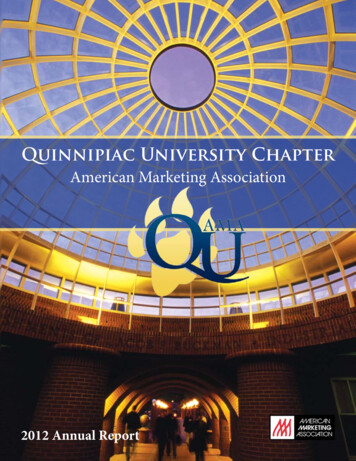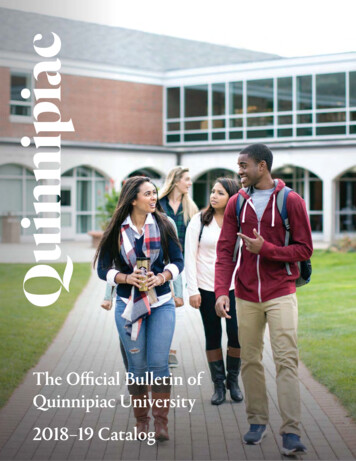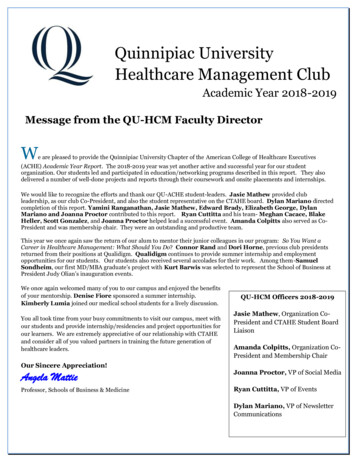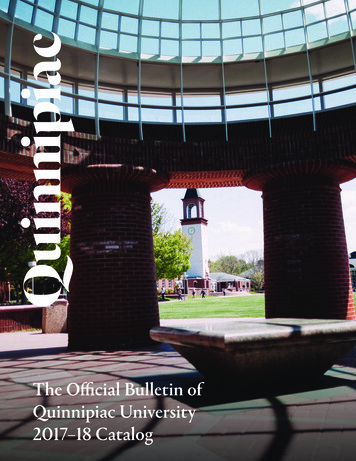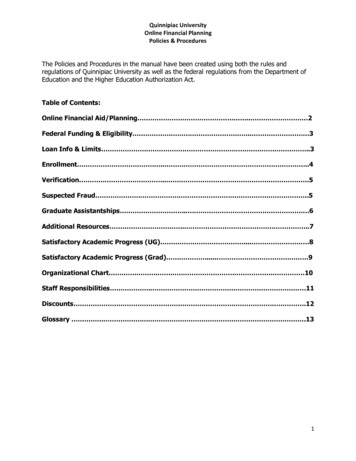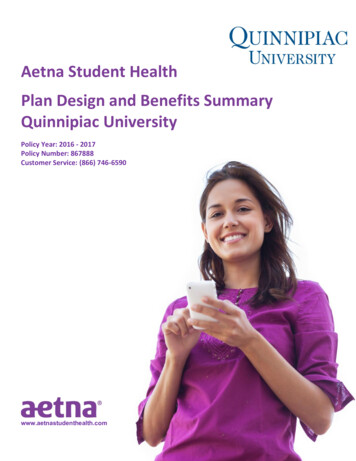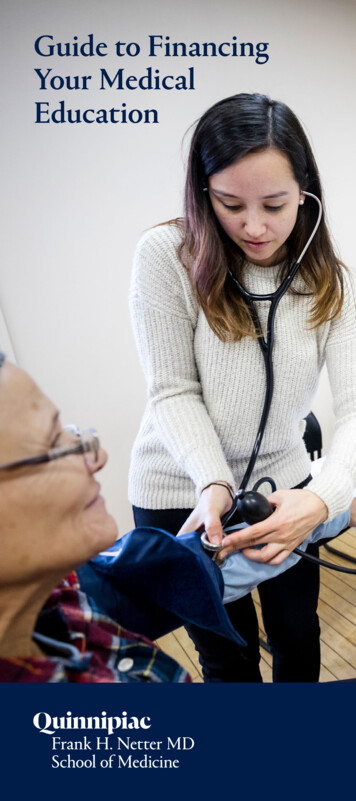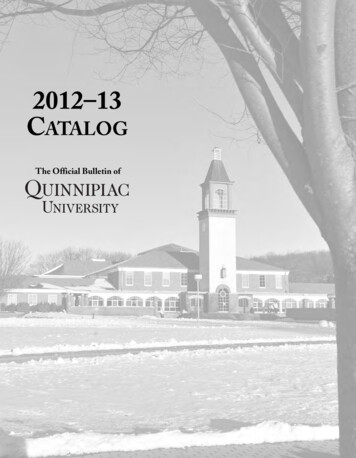
Transcription
2012–13CATALOGThe Official Bulletin of
Copyright 2012Quinnipiac University, Hamden, ConnecticutVisit us at rsityFollow us on Twitter @QuinnipiacUNo section of this catalog may be copied or reproduced without the permission of theDivision of Public Affairs, Quinnipiac University.Admission requirements, fees, rules and regulations and academic programs are updated in official bulletinsof the University. The University reserves the right to change the contents of this catalog at any time.Photography by Kristen Carranza, Al Ferreira, Stan Godlewski, John Hassett, Robert Lisak, Frank Poole,Mark Stanczak, Carl Talley, Gale ZuckerPrinted in Canada2
CONTENTSStatements on Nondiscrimination and Compliance . . . . . . . . . . . . . . . . . . . . . . . . . . . . . . . . . . .4Letter from the President . . . . . . . . . . . . . . . . . . . . . . . . . . . . . . . . . . . . . . . . . . . . . . . . . . . . . . . . .5Accreditations and Professional Memberships . . . . . . . . . . . . . . . . . . . . . . . . . . . . . . . . . . . . . . .6General Information . . . . . . . . . . . . . . . . . . . . . . . . . . . . . . . . . . . . . . . . . . . . . . . . . . . . . . . . . . . . .7Academic Calendars . . . . . . . . . . . . . . . . . . . . . . . . . . . . . . . . . . . . . . . . . . . . . . . . . . . . . . . . . . . . .8About Quinnipiac University . . . . . . . . . . . . . . . . . . . . . . . . . . . . . . . . . . . . . . . . . . . . . . . . . . . . .10Academic Information . . . . . . . . . . . . . . . . . . . . . . . . . . . . . . . . . . . . . . . . . . . . . . . . . . . . . . . . . .17College of Arts and Sciences . . . . . . . . . . . . . . . . . . . . . . . . . . . . . . . . . . . . . . . . . . . . . . . . . . . . .53School of Business and Engineering . . . . . . . . . . . . . . . . . . . . . . . . . . . . . . . . . . . . . . . . . . . . . . .91School of Communications . . . . . . . . . . . . . . . . . . . . . . . . . . . . . . . . . . . . . . . . . . . . . . . . . . . . .113School of Health Sciences . . . . . . . . . . . . . . . . . . . . . . . . . . . . . . . . . . . . . . . . . . . . . . . . . . . . . .121School of Nursing . . . . . . . . . . . . . . . . . . . . . . . . . . . . . . . . . . . . . . . . . . . . . . . . . . . . . . . . . . . . .151Part-time Undergraduate Studies . . . . . . . . . . . . . . . . . . . . . . . . . . . . . . . . . . . . . . . . . . . . . . . .157Graduate and Online Studies . . . . . . . . . . . . . . . . . . . . . . . . . . . . . . . . . . . . . . . . . . . . . . . . . . . .165School of Education . . . . . . . . . . . . . . . . . . . . . . . . . . . . . . . . . . . . . . . . . . . . . . . . . . . . . . . . . . .188Undergraduate and Graduate Course Descriptions . . . . . . . . . . . . . . . . . . . . . . . . . . . . . . . . .215Student and Campus Life . . . . . . . . . . . . . . . . . . . . . . . . . . . . . . . . . . . . . . . . . . . . . . . . . . . . . . .367Board of Trustees . . . . . . . . . . . . . . . . . . . . . . . . . . . . . . . . . . . . . . . . . . . . . . . . . . . . . . . . . . . . . .380President’s Cabinet . . . . . . . . . . . . . . . . . . . . . . . . . . . . . . . . . . . . . . . . . . . . . . . . . . . . . . . . . . . .380Administration . . . . . . . . . . . . . . . . . . . . . . . . . . . . . . . . . . . . . . . . . . . . . . . . . . . . . . . . . . . . . . . .381Faculty . . . . . . . . . . . . . . . . . . . . . . . . . . . . . . . . . . . . . . . . . . . . . . . . . . . . . . . . . . . . . . . . . . . . . . .381Index . . . . . . . . . . . . . . . . . . . . . . . . . . . . . . . . . . . . . . . . . . . . . . . . . . . . . . . . . . . . . . . . . . . . . . . .3933
Statements on Nondiscrimination and ComplianceQuinnipiac University has a strong commitment to the principles and practices of diversity throughout theUniversity community. Women, members of minority groups and individuals with disabilities areencouraged to consider and apply for admission. Quinnipiac does not discriminate on the basis of race,color, creed, gender, age, sexual orientation, national and ethnic origin, or disability status in theadministration of its educational and admissions policies, employment policies, scholarship and loanprograms, athletic programs or other University-administered programs.Quinnipiac is in compliance with Section 504 of the Rehabilitation Act of 1973 and the Americanswith Disabilities Act of 1990, and inquiries should be directed to the Learning Center or to the Office ofHuman Resources. Quinnipiac complies with the Student Right to Know and Campus Security Act(PL 103-542) and those reports are available from the Office of Public Affairs. Quinnipiac maintains allfederal and state requirements for a drug-free campus and workplace; information on student drug andalcohol programs is published in the Student Handbook and employee information is distributed throughthe Office of Human Resources. Graduation reports are available upon request from the Offices ofAdmissions and Registrar. Reports on athletic programs are available from the Department of Athleticsand Recreation.4
Dear Students,The essence of a university lies in itspeople and in its programs. We atQuinnipiac University have reason to beproud of our programs and all the members ofour University community. We take care to ensurethat the students who enroll at Quinnipiac areprepared to make their contributions asresponsible professionals and community leadersin a culturally rich and diverse society.As you look through the pages of the catalog,consider the three values upon which Quinnipiac University was founded:high-quality academic programs, a student-oriented environment and thefostering of a sense of community among all of the members of theQuinnipiac family. We continue to be committed to these importantvalues and to providing the best possible living and learning environmentfor our students.I welcome you to Quinnipiac University, and I look forward to seeing youon campus.John L. LaheyPresident5
Accreditations and Professional MembershipsQuinnipiac University is accredited by the New England Association of Schools and Colleges, Inc., whichaccredits schools and colleges in the six New England states. Accreditation by the association indicatesthat the institution has been evaluated carefully and found to meet standards agreed upon by qualifiededucators.Quinnipiac also is accredited by the Board of Higher Education of the state of Connecticut and isauthorized by the General Assembly of the state to confer such degrees and grant such diplomas as areauthorized by the board.All programs in health sciences have been approved by appropriate state and national agencies or are inthe process of accreditation. The physical therapy program is accredited by the Commission on Accreditation in Physical Therapy Education (CAPTE). The occupational therapy program is accredited by theAccreditation Council for Occupational Therapy Education (ACOTE). The undergraduate and the masterof science in nursing program are accredited by the National League for Nursing Accrediting Commission(NLNAC). Both the undergraduate and graduate nursing programs are seeking accreditation with theCommission on Collegiate Nursing Education (CCNE). The physician assistant program is accredited bythe Accreditation Review Commission on Education for the Physician Assistant, Inc. (ARC-PA). Thepathologists’ assistant program is accredited by the National Accrediting Agency for Clinical LaboratorySciences (NAACLS). The athletic training program is accredited by the Commission on Accreditation ofAthletic Training Education (CAATE).The bachelor’s degree program in diagnostic imaging is accredited by the Joint Review Committee onEducation in Radiologic Technology. The cardiovascular perfusion program is accredited by theCommission on Accreditation of Allied Health Education Programs.Quinnipiac’s undergraduate and graduate business programs are accredited by AACSB International—The Association to Advance Collegiate Schools of Business. As a school of business with AACSBaccredited business programs, Quinnipiac meets or exceeds established standards, as determined byperiodic AACSB peer group review. The AACSB quality standards relate to curriculum, faculty resources,admission, degree requirements, library and computer facilities, financial resources and intellectual climate.The BS in computer information systems program is accredited by ABET, Inc.The State Bar Examining Committee has approved the undergraduate programs of Quinnipiac forprelaw education, and the American Bar Association has approved the legal studies bachelor’s degreeprogram.Quinnipiac has received full approval from the American Bar Association to award the JD degreethrough the Quinnipiac University School of Law. The American Bar Association also has acquiesced inthe offering by the Quinnipiac University School of Law of the Master of Laws in Health Law (the“Health Law LLM”). (Under its standards, the ABA does not “approve” post-JD programs such as theLLM, but only considers whether it will or will not “acquiesce” in such proposed programs at an accreditedlaw school.) The Quinnipiac University School of Law is also a member of the Association of AmericanLaw Schools.The master of arts in teaching program is fully accredited by the National Council for Accreditationof Teacher Education (NCATE) and the Connecticut Department of Education. The U.S. Department ofEducation recognizes NCATE as a specialized accrediting body for schools, colleges and departmentsof education. The educational leadership program is fully accredited by the CT State Department ofEducation and is aligned with the leadership standards of NCATE.Students may review information on the various accrediting agencies and accrediting reports bycontacting the Office of the Senior Vice President for Academic and Student Affairs.Quinnipiac reserves the right to change any provisions of this catalog at any time.6
GENERAL INFORMATION2012–13 Academic Calendar . . . . . . . . . . . . . . . . . . . . . . . . . . . . . . . . . . . . . . . . . . . . . . . . . . . . . . .82013–14 Academic Calendar . . . . . . . . . . . . . . . . . . . . . . . . . . . . . . . . . . . . . . . . . . . . . . . . . . . . . . .9About Quinnipiac University . . . . . . . . . . . . . . . . . . . . . . . . . . . . . . . . . . . . . . . . . . . . . . . . . . . . .10Mission Statement . . . . . . . . . . . . . . . . . . . . . . . . . . . . . . . . . . . . . . . . . . . . . . . . . . . . . . . . . . . .10A Student-Oriented University . . . . . . . . . . . . . . . . . . . . . . . . . . . . . . . . . . . . . . . . . . . . . . . . .10Center for Excellence in Teaching and Service to Students . . . . . . . . . . . . . . . . . . . . . . . . . .11A Community of Learning . . . . . . . . . . . . . . . . . . . . . . . . . . . . . . . . . . . . . . . . . . . . . . . . . . . . .11Admission . . . . . . . . . . . . . . . . . . . . . . . . . . . . . . . . . . . . . . . . . . . . . . . . . . . . . . . . . . . . . . . . . . . . . .12Admission Procedures . . . . . . . . . . . . . . . . . . . . . . . . . . . . . . . . . . . . . . . . . . . . . . . . . . . . . . . . .12Admission Requirements . . . . . . . . . . . . . . . . . . . . . . . . . . . . . . . . . . . . . . . . . . . . . . . . . . . . . . .12Transfer Requirements . . . . . . . . . . . . . . . . . . . . . . . . . . . . . . . . . . . . . . . . . . . . . . . . . . . . . . . . .13International Student Admission . . . . . . . . . . . . . . . . . . . . . . . . . . . . . . . . . . . . . . . . . . . . . . . .13Admission Selection Process . . . . . . . . . . . . . . . . . . . . . . . . . . . . . . . . . . . . . . . . . . . . . . . . . . . .13University Laptop Program . . . . . . . . . . . . . . . . . . . . . . . . . . . . . . . . . . . . . . . . . . . . . . . . . . . . .13Advanced Standing/Placement . . . . . . . . . . . . . . . . . . . . . . . . . . . . . . . . . . . . . . . . . . . . . . . . . .14Tuition and Fees . . . . . . . . . . . . . . . . . . . . . . . . . . . . . . . . . . . . . . . . . . . . . . . . . . . . . . . . . . . . . . . .14Summary of Charges . . . . . . . . . . . . . . . . . . . . . . . . . . . . . . . . . . . . . . . . . . . . . . . . . . . . . . . . . .14Resident Fee (Room and Board) . . . . . . . . . . . . . . . . . . . . . . . . . . . . . . . . . . . . . . . . . . . . . . . . .14Financial Aid . . . . . . . . . . . . . . . . . . . . . . . . . . . . . . . . . . . . . . . . . . . . . . . . . . . . . . . . . . . . . . . . . . .15Academic Scholarships . . . . . . . . . . . . . . . . . . . . . . . . . . . . . . . . . . . . . . . . . . . . . . . . . . . . . . . . .15Air Force Reserve Officer Training Corps (AFROTC) . . . . . . . . . . . . . . . . . . . . . . . . . . . . .16Army Reserve Officer Training Corps (ROTC) . . . . . . . . . . . . . . . . . . . . . . . . . . . . . . . . . . . .16Veterans Benefits . . . . . . . . . . . . . . . . . . . . . . . . . . . . . . . . . . . . . . . . . . . . . . . . . . . . . . . . . . . . . .16G E N E R A L I N F O R M AT I O N7
2012–13 Academic Calendar*excludes School of LawFall 2012August 22–26August 27August 31September 3September 8September 22September 26October 12–13October 20November 2*November 10November 19–24November 22–23December 8*December 10–15*December 17Dec. 24–Jan. �FriSaturdayMon–SatMondayMon–TuesNew undergraduate student orientationUndergraduate and graduate classes beginLast day for late registration/schedule changesLabor Day—University holiday; no classesAll Saturday classes beginOpen House for prospective undergraduate studentsYom Kippur—University holiday; no classesParents & Family WeekendOpen House for prospective undergraduate studentsLast day to withdraw from undergraduate and graduate classes with a grade of “W”Open House for prospective undergraduate studentsNo classesThanksgiving holiday—University closedUndergraduate and graduate classes endFinal examination period—undergraduate and graduate classesFinal grades dueUniversity closedJanuary Term 2013*January 1January 2January 18January 21January 22TuesdayWednesdayFridayMondayTuesdayNew Year’s Day—University holidayUndergraduate and graduate classes beginClasses end; final examinationsMartin Luther King Jr. Day—University closed; no classesFinal grades dueSpring 2013Jan. 17–18January 21January 22*January 25January 26March 11–16March 23–24March 29April 5*April 13May 4*May 6–11*May 12May 13May 19May 27May 31–June 1June 7–8June tNew undergraduate student orientationMartin Luther King Jr. Day—University holiday; no classesUndergraduate and graduate classes beginLast day for late registration or schedule changesSaturday classes beginUndergraduate and graduate spring recessAdmitted Student DaysGood Friday—University holiday; no classesLast day to withdraw from undergraduate classes with a grade of “W”Undergraduate and Senior Award CeremoniesUndergraduate and graduate classes endFinal examination period—undergraduate and graduate classesGraduate and Law CommencementsFinal grades due; Junior Open House for prospective studentsUndergraduate CommencementMemorial Day—University holidayNew Student OrientationNew Student OrientationNew Student OrientationSummer Term 2013 (dates may change)Summer IMay 28–June 29 (5 weeks)May 28–July 13 (7 weeks)July 4–University holiday; no classesSummer IIJuly 15–August 17 (5 weeks)8G E N E R A L I N F O R M AT I O NThe University reserves the right to revise this calendar.
2013–14 Academic Calendar*excludes School of LawFall 2013August 21–25August 26August 30September 2September 7September 13September 14September 21October 19October 25–27November 1*November 9November 25–30November 28–29December 7*December 9–14*December 17Dec. 24–Jan. urs–FriSaturdayMon–SatTuesdayTues–WedNew undergraduate student orientationUndergraduate and graduate classes beginLast day for late registration/schedule changesLabor Day—University holiday; no classesAll Saturday classes beginYom Kippur—University holiday; no classesNo classesOpen House for prospective undergraduate studentsOpen House for prospective undergraduate studentsParents & Family WeekendLast day to withdraw from undergraduate and graduate classes with a grade of “W”Open House for prospective undergraduate studentsNo ClassesThanksgiving holiday—University closedUndergraduate and graduate classes endFinal examination period—undergraduate and graduate classesFinal grades dueUniversity closedJanuary Term 2014*January 2January 17January 20January 21ThursdayFridayMondayTuesdayUndergraduate and graduate classes beginClasses end; Final examinationsMartin Luther King, Jr. Day—University holiday; no classesFinal grades ayMondaySundayMondayNew undergraduate student orientationMartin Luther King, Jr. Day—University holiday; no classesUndergraduate and graduate classes beginSaturday classes beginLast day for late registration or schedule changesUndergraduate and graduate spring recessLast day to withdraw from undergraduate classes with a grade of “W”Admitted Student DaysUndergraduate and Senior Award CeremoniesGood Friday—University holiday; no classesUndergraduate and graduate classes endFinal examination period—undergraduate and graduate classesGraduate and Law CommencementsFinal grades due; Junior Open House for prospective studentsUndergraduate CommencementMemorial Day—University holiday; no classesNew Student OrientationSpring 2014Jan. 16–17January 20January 21*January 25January 27March 10–15March 28*March 29–30April 12April 18May 3*May 5–10*May 11May 12May 18May 26TBD/ JuneSummer Term 2014Summer IMay 19–June 21 (5 weeks)May 19–July 3 (7 weeks)Summer IIJuly 7–August 8 (5 weeks)The University reserves the right to revise this calendar.G E N E R A L I N F O R M AT I O N9
About Quinnipiac UniversityQuinnipiac today is a thriving, three-campusuniversity located in southern Connecticut. Itoffers more than 70 programs to 6,000 undergraduates and more than 2,000 graduate andlaw students.The University, founded in New Haven in1929 with an emphasis on business, was known asthe Connecticut College of Commerce until itchanged its name in 1951 to Quinnipiac College.Soon thereafter, having outgrown its New Havensurroundings, the University moved to its 250-acreMount Carmel Campus in Hamden, Conn.,90 minutes north of New York City, two hoursfrom Boston and eight miles from metropolitanNew Haven.In 2000, the name Quinnipiac University wasadopted to better reflect the quality and diversityof the school’s programs at both the undergraduateand graduate levels.Over the years, Quinnipiac has experienceddramatic and steady growth in the quality andscope of its academic programs. The early focuson business has now expanded to includenationally recognized programs in health sciences,communications, education, law, nursing andarts and sciences.In 2007, Quinnipiac dedicated its TD BankSports Center, the first of several buildings on its250-acre York Hill Campus. The center housesseparate arenas for the University’s Division Imen’s and women’s ice hockey and basketballteams. York Hill also contains residence halls for2,000 students, the Rocky Top Student Center andfitness facility, and a 2,000-car parking garage.A third 104-acre campus in nearby NorthHaven serves as home to the School of Education,the School of Health Sciences and the School ofNursing, the Frank H. Netter MD School ofMedicine, as well as many graduate programs.Throughout its history, Quinnipiac hasremained true to its three core values: high-qualityacademic programs, a student-orientedenvironment and a sense of community.The University is easily reached via theConnecticut Turnpike (Interstates 95 and 91), theMerritt Parkway (Route 15) and Interstate 84.10G E N E R A L I N F O R M AT I O NQuinnipiac University Mission StatementAn education at Quinnipiac embodies theUniversity’s commitment to three core values:high-quality academic programs, a student-orientedenvironment and a strong sense of community.The University prepares undergraduate andgraduate students for achievement and leadershipin business, communications, health, education, law,nursing and the liberal arts and sciences.Quinnipiac University educates students to bevalued and contributing members of their communities through a vital, challenging and purposefuleducational program. Students engage real-worldissues through practice and the consideration ofdifferent perspectives. The University’s innovativeQU seminar series further prepares undergraduatesto understand their role and responsibilities asmembers of the Quinnipiac community, as well asthe larger national and global communities.To fulfill its educational mission Quinnipiac: offers degree programs centered on effectivepractice that are strengthened by the integrationof a liberal education; cultivates critical thinking, intellectual integrity,curiosity and creativity in the pursuit ofknowledge; provides a variety of learning and serviceexperiences to facilitate student achievement; maintains a strong commitment to a diverse andinclusive student body, faculty and staff; fosters an understanding of and respect for themultiplicity of human perspectives and beliefsystems; supports faculty teacher-scholars who areeffective teachers and who engage in scholarshipwith valuable intellectual and practical results.A Student-Oriented UniversityQuinnipiac is committed to making each student’sexperience a satisfying and rewarding one. Itstrives to do this in both personal and academiccontexts. Students are represented on all key bodiesinvolved in decision making, including the Boardof Trustees.The Student Government Association is involvedin fundamental University issues, as well as ongoingcampus events. Activity clubs, organizations,societies, fraternities, sororities and ethnic, religious,cultural and political groups all play important rolesin the day-to-day life of the community.
In keeping with the value system at Quinnipiac,emphasis is on the individual, not on social oreconomic standing. Students are selected solely onthe basis of merit and qualifications, with majorconsideration given to the innate qualities ofmotivation and character.As a result, the student body reflects a widespectrum of racial, religious and economicbackgrounds, personalities and lifestyles thatprovide diverse social and cultural experiences.The cosmopolitan student community represents26 states throughout the United States as well as14 countries abroad.Center for Excellence in Teaching andService to StudentsThe Center for Excellence in Teaching and Serviceto Students encourages, supports and recognizessuperior teaching and service to students atQuinnipiac University. The center serves as animportant vehicle in helping the University achieveits educational mission, consistent with its threecore values: high-quality academic programs, astudent-oriented environment and a sense ofcommunity.The center sponsors a variety of professionaldevelopment programs and activities using its ownrole models and expertise within the faculty andstaff, as well as external consultants and experts. Italso sponsors workshops and seminars, conductsstudent, faculty and staff surveys, and hosts specialrecognition events. The annual Excellence inService to Students Award and Excellence inTeaching Award reflect the highest recognition ofexcellence at Quinnipiac University.The center is supported through the president’soffice and is guided by a rotating board of directorsconsisting of representatives from the faculty, staffand students.A Community of LearningEffective learning takes place at many levelsbeyond the traditional teacher-classroom situation,and Quinnipiac encourages flexibility in thelearning process.Students in the School of Health Sciences andSchool of Nursing use hospitals and medical andresearch centers for their clinical laboratoryexperiences. Students in the School of Businesshave working contact with private and publicbusiness operations. Students in the School ofCommunications complete internships in thebroadcast, print and film media, in cable televisionand sound recording industries, and in variousvideo production, advertising and public relationsoperations. Students in the College of Arts andSciences participate in community activities andprograms. Students in the School of Educationcomplete internships in public schools.Recognizing that the learning process has nobounds, Quinnipiac requires students to take aUniversity Curriculum regardless of theirenrollment in a particular school or program.Further, as citizens of a learning community, thefaculty members interact in the learning process asparticipants rather than mere dispensers of facts.The Division of Student Affairs also supportsgrowth and development of the Quinnipiaccommunity through a variety of cocurricularprograms that complement academic efforts.G E N E R A L I N F O R M AT I O N11
AdmissionAdmission ProceduresConsistent with the University mission, Quinnipiacwelcomes inquiries from serious students of all ageswho are interested in professional preparation infields related to health sciences, business, education,engineering, communications, nursing, public service, and the theoretical and applied disciplines inarts and sciences. An education at Quinnipiac integrates technical, professional and liberal studies. Thestudents who benefit most from Quinnipiac arethose who are motivated for a life of professionalservice and prepared to undertake a program ofstudies that is broad in its cultural perspectives,while being focused in its technical and professionaldimensions. Quinnipiac University seeks studentswho wish to pursue professional careers, includingthose who, as yet, are undecided on their fields.Students interested in Quinnipiac Universityare urged to acquaint themselves thoroughly withQuinnipiac as early in their decision-makingprocess as possible. A campus visit and admissionsinterview is strongly recommended. If a campusvisit is not possible, prospective students areadvised to meet with one of Quinnipiac’s representatives when they visit the student’s school, or tomake arrangements for a telephone conference.The admissions office hosts on-campus interviewsMonday through Friday year-round and groupinformation sessions weekdays throughout the yearand on Saturday mornings during the fall and springsemesters. Fall and spring open houses, AdmittedStudent Days (in late March and early April) andonline chat sessions also provide opportunities tolearn more about Quinnipiac. We welcome yourinterest. Please call our toll-free number,800-462-1944 or 203-582-8600, visit our websitewww.quinnipiac.edu/visit, or email us atadmissions@quinnipiac.edu.Admission RequirementsAdmission to Quinnipiac University is competitive,and applicants are expected to present a strong college prep program in high school, along with official scores of all standardized tests taken (SATand/or ACT). The admissions staff looks for a B orhigher grade point average in a challenging academic program through the senior year, and usesthe highest individual scores on the SAT in critical12G E N E R A L I N F O R M AT I O Nreading, math and writing or the highest ACTcomposite score. The admissions website provides arange of information on the number of applicantsand average scores, including ethnic and geographicinformation about the recent incoming class.All freshman applicants for admission areexpected to present:1. A high school diploma from an approvedsecondary school or its equivalent.2. A secondary school transcript showing as completed, or in progress, a college preparatorysequence including: English, four units; mathematics, three units (physical and occupationaltherapy, nursing and physician assistant applicants should have four years); science, threeunits (all health science applicants are expectedto have biology and chemistry; physical therapyapplicants should also have physics); social science, two units; academic (college preparatory)electives, four units. Total academic unitsexpected: 16. First quarter grades in the senioryear should be sent as soon as they are available.3. All official score results for the ScholasticReasoning Test (SAT I) of the College EntranceExamination Board (CEEB) or of the AmericanCollege Testing Program (ACT).4. A completed Quinnipiac University application,or the Common Application plus QuinnipiacSupplement together with a non-refundableapplication fee of 45.5. A personal statement or essay (250-wordminimum).6. An interview is recommended but not required.7. A teacher or counselor letter of recommendation.
Transfer RequirementsTransfer applicants must submit the documentslisted above for freshmen with the followingexceptions:1. An official transcript from each post-highschool institution attended, even if no courseswere completed.2. Applicants who graduated from high schoolmore than five years ago or have successfullycompleted the equivalent of one year (30 credits)of college study are not required to submitentrance examination scores.3. Students seeking a second bachelor’s degreeneed only submit transcripts of their collegework and the application form.4. The application fee for transfer applicants is 45.International Student AdmissionApplications for undergraduate study from international students are welcomed. Upon application,international students are requested to submitEnglish language descriptions of secondaryschools, colleges and universities attended.In addition, applicants from non-E
Quinnipiac University is accredited by the New England Association of Schools and Colleges, Inc., which accredits schools and colleges in the six New England states. Accreditation by the association indicates that the institution has been evaluated carefully and found to meet standards agreed upon by qualified educators.
